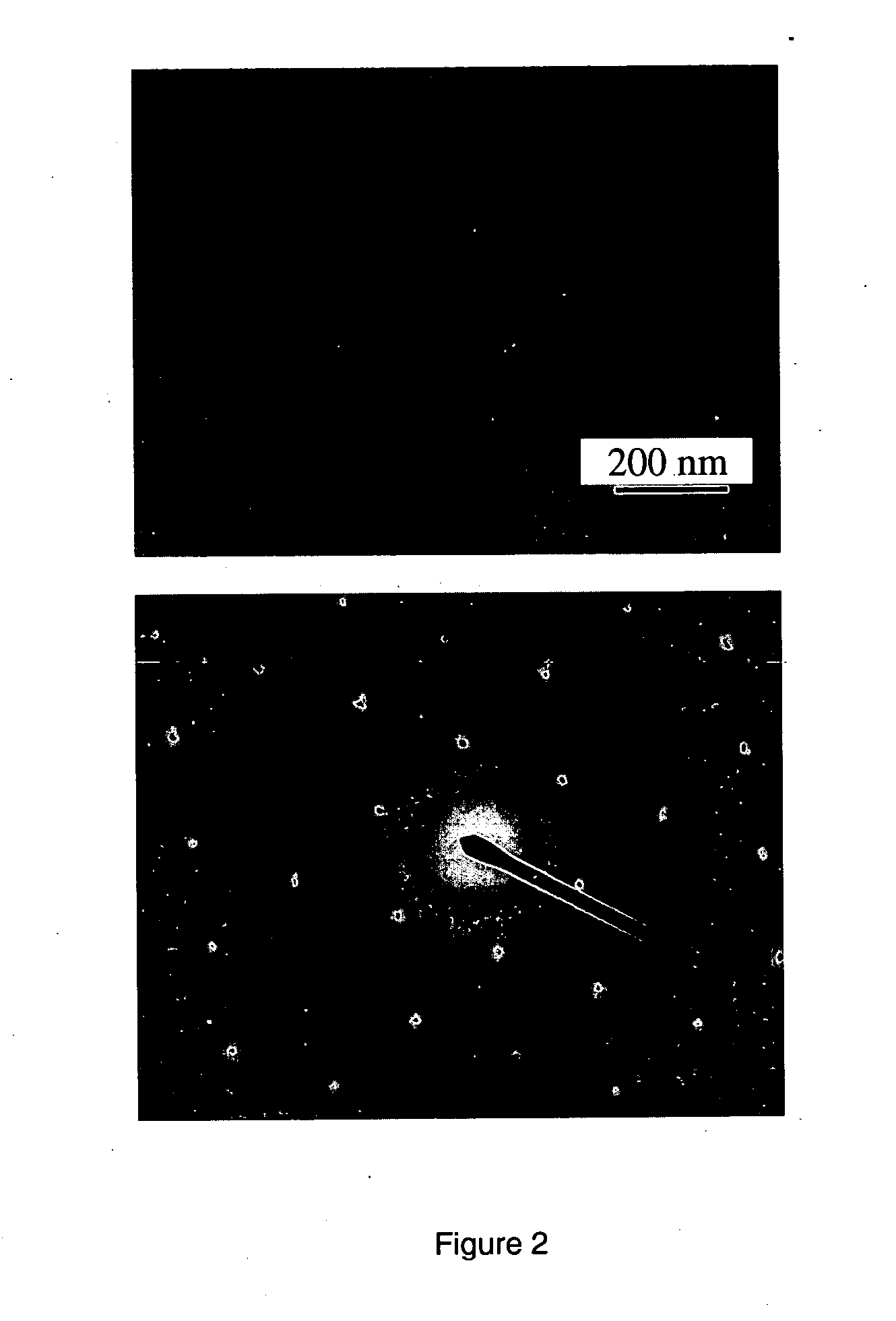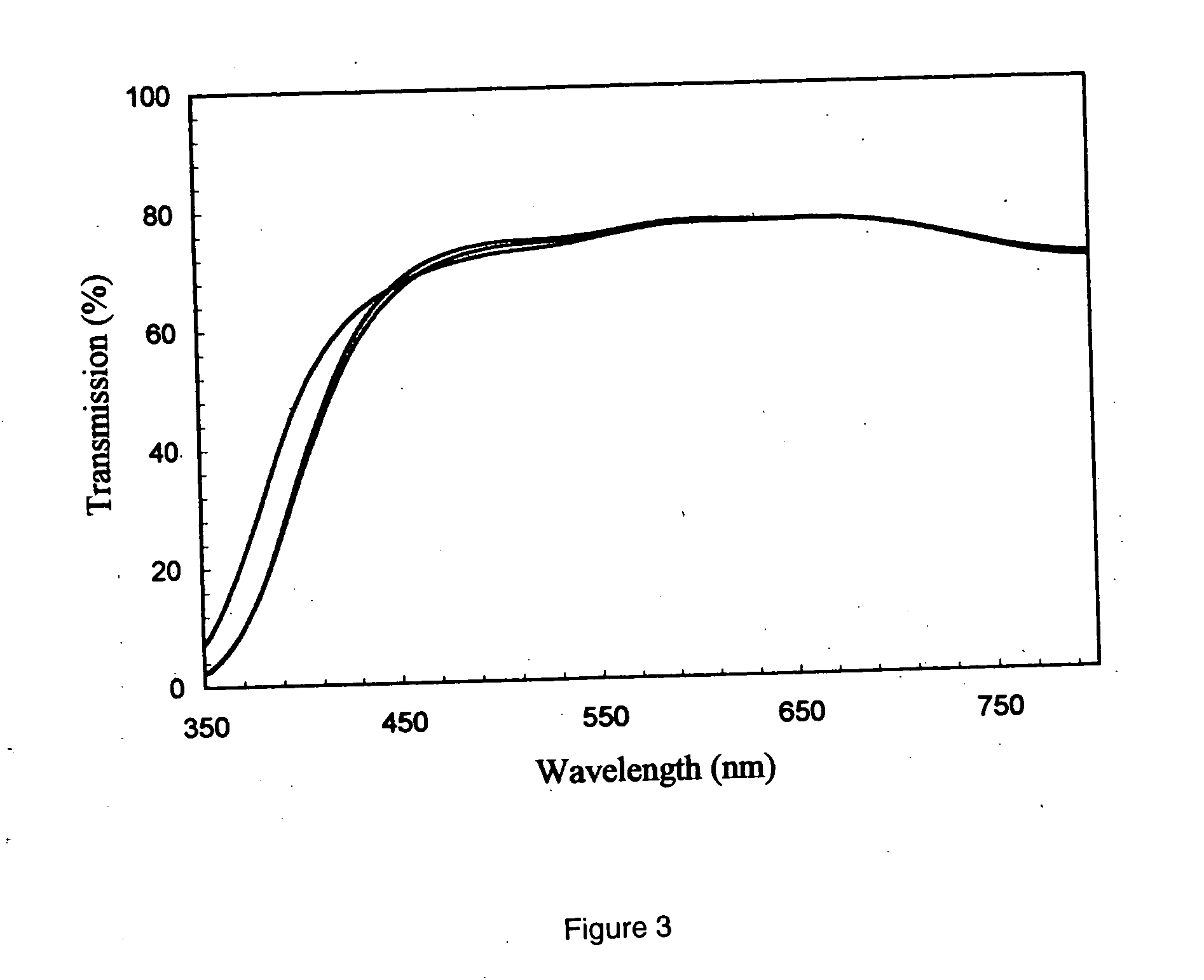Monoclinic CeTi2O6 thin film and sol-gel process for the preparation thereof
- Summary
- Abstract
- Description
- Claims
- Application Information
AI Technical Summary
Benefits of technology
Problems solved by technology
Method used
Image
Examples
example 1
[0058] 0.22 M solution of cerium chloride heptahydrate (CeCl3.7H2O, Merck) has been prepared in absolute ethanol (C2H5OH, Merck). The above clear, colorless solution has been added to titanium propoxide such that the Ce:Ti mole ratio in the solution is 0.5:1. The resultant bright yellow solution has been stirred for 5 min. After allowing the commencement of gelation in the resultant yellow solution, the sol has been spin coated on to fluorine doped tin oxide coated glass substrates and micro slide glass substrates at 3000 rpm for 35 s followed by drying in air for 15 min. Subsequently, the films have been thermally treated at 600° C. for 5 min. in air at a heating rate of 1-2° C.min−1. The films prepared as above with thickness 6800 Å were tested for their optical passivity in a test cell containing a test electrolyte of 1 M lithium perchlorate in propylene carbonate and a platinum electrode. The XRD results (FIG. 1) have shown the formation of pure CeTi2O6 phase in the films with a...
example 2
[0059] 0.22 M solution of cerium chloride heptahydrate (CeCl3.7H2O, Merck) has been prepared in absolute ethanol (C2H5OH, Merck). The above clear, colorless solution has been added to titanium propoxide such that the Ce:Ti mole ratio in the solution is 0.6:1. The resultant bright yellow solution has been stirred for 5 min. After allowing the commencement of gelation in the resultant yellow solution, the sol has been spin coated on to fluorine doped tin oxide coated glass substrates and micro slide glass substrates at 3000 rpm for 35 s followed by drying in air for 15 min. Subsequently, the films have been thermally treated at 600° C. for 5 min. in air at a heating rate of 1-2° C.min−1. The films prepared as above with thickness 6200 Å were tested for their optical passivity in a test cell containing a test electrolyte of 1 M lithium perchlorate in propylene carbonate and a platinum electrode. The films have shown a transmission modulation of less than 1% at 550 nm. The transmission ...
example 3
[0060] 0.22 M solution of cerium chloride heptahydrate (CeCl3.7H2O, Merck) has been prepared in absolute ethanol (C2H5OH, Merck). The above clear, colorless solution has been added to titanium propoxide such that the Ce:Ti mole ratio in the solution is 0.4:1. The resultant bright yellow solution has been stirred for 5 min. After allowing the commencement of gelation in the resultant yellow solution, the sol has been spin coated on to fluorine doped tin oxide coated glass substrates and micro slide glass substrates at 3000 rpm for 35 s followed by drying in air for 15 min. Subsequently, the films have been thermally treated at 600° C. for 5 min. in air at a heating rate of 1-2° C.min−1. The films prepared as above with thickness 10,000 Å were tested for their optical passivity in a test cell containing a test electrolyte of 1 M lithium perchlorate in propylene carbonate and a platinum electrode. The films have shown a transmission modulation of less than 1% at 550 nm. The transmissio...
PUM
| Property | Measurement | Unit |
|---|---|---|
| Temperature | aaaaa | aaaaa |
| Temperature | aaaaa | aaaaa |
| Fraction | aaaaa | aaaaa |
Abstract
Description
Claims
Application Information
 Login to View More
Login to View More - R&D
- Intellectual Property
- Life Sciences
- Materials
- Tech Scout
- Unparalleled Data Quality
- Higher Quality Content
- 60% Fewer Hallucinations
Browse by: Latest US Patents, China's latest patents, Technical Efficacy Thesaurus, Application Domain, Technology Topic, Popular Technical Reports.
© 2025 PatSnap. All rights reserved.Legal|Privacy policy|Modern Slavery Act Transparency Statement|Sitemap|About US| Contact US: help@patsnap.com



